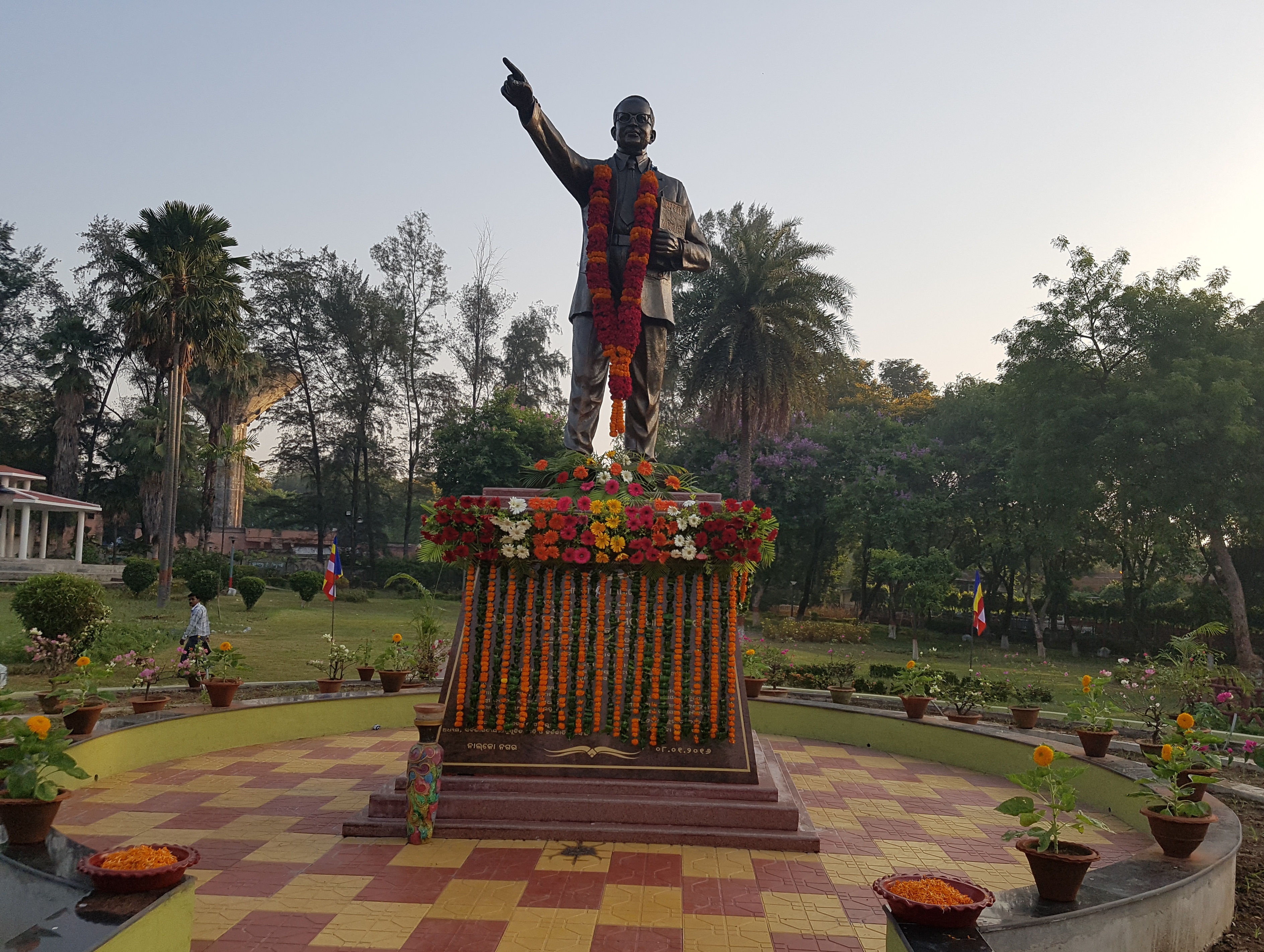|
Sankarjang
Sankarjang (20°52’08“N; 84°59’19“E), Odisha, India is an archaeological site near Angul, a former cemetery and settlement with large, worked stones but no one knows what they were made for, although some people think they might have been part of a lithophone . This site was test excavated by the State Archaeology Department of Odisha after a chance find of 20 long unfinished chipped and ground, lithic bars and axes of basalt, together with human skeletal remains and metallic artifacts, by a shepherd in 1971. Archaeologists understood ground stone lithics to be typical of the Neolithic Period although they were in production later. The elegant lithics from Sankarjang resemble elaborate ones from eastern Asia and the South Seas. Such lithics played a key role in the definition of R. von Heine-Geldern’s Austronesian culture. The incisor teeth of nine bodies interred in the graves had a "shovel" form which suggests Mongolian affinities. The absolute chronology rests on ... [...More Info...] [...Related Items...] OR: [Wikipedia] [Google] [Baidu] |
Lithophones
A lithophone is a musical instrument consisting of a rock or pieces of rock which are struck to produce musical notes. Notes may be sounded in combination (producing harmony) or in succession (melody). It is an idiophone comparable to instruments such as the glockenspiel, vibraphone, xylophone and marimba. In the Hornbostel-Sachs classification system, lithophones are designated as '111.22' – directly-struck percussion plaques. Notable examples A rudimentary form of lithophone is the "rock gong", usually a natural rock formation opportunistically adapted to produce musical tones, such as that on Mfangano Island, in Lake Victoria, Kenya. The Great Stalacpipe Organ of Luray Caverns, Virginia, USA uses 37 stalactites to produce the Western scale. Other stalactite lithophones are at Tenkasi in South India, and at Ringing Rocks Park in Pennsylvania. An example that is no longer used is at Cave of the Winds, in Colorado Springs. The Txalaparta (or Chalaparta), a tradition ... [...More Info...] [...Related Items...] OR: [Wikipedia] [Google] [Baidu] |
Lithophone
A lithophone is a musical instrument consisting of a rock or pieces of rock which are struck to produce musical notes. Notes may be sounded in combination (producing harmony) or in succession (melody). It is an idiophone comparable to instruments such as the glockenspiel, vibraphone, xylophone and marimba. In the Hornbostel-Sachs classification system, lithophones are designated as '111.22' – directly-struck percussion plaques. Notable examples A rudimentary form of lithophone is the "rock gong", usually a natural rock formation opportunistically adapted to produce musical tones, such as that on Mfangano Island, in Lake Victoria, Kenya. The Great Stalacpipe Organ of Luray Caverns, Virginia, USA uses 37 stalactites to produce the Western scale. Other stalactite lithophones are at Tenkasi in South India, and at Ringing Rocks Park in Pennsylvania. An example that is no longer used is at Cave of the Winds, in Colorado Springs. The Txalaparta (or Chalaparta), a tradition ... [...More Info...] [...Related Items...] OR: [Wikipedia] [Google] [Baidu] |
Paul Alan Yule
Paul Alan Yule is a German archaeologist at the Ruprecht-Karls-Universität Heidelberg (habilitation). His main work targets the archaeology of Oman, Yemen, previously India. Education and career Yule studied at the University of Minnesota (BA), New York University (MA and PhD) and Marburg University. His dissertation, ''Early Cretan Seals'', classified and dated the seals from the Early and Middle Bronze Ages of Minoan Crete. In 1995 his habilitationsschrift at Heidelberg University analysed some 365 pre-Islamic graves in the eastern central part of Oman Within the framework of the Open Access movement Yule emphasises the archiving of his research materials and publications as soon as possible so as to make them publicly available. He does this largely by means of the image bank heidICON and the virtual library Propylaeum-Dok of the Heidelberg University Library. Since 2005 Yule has experimented in 3D recording and animation in India and Oman with the Fachhochschule Mainz ... [...More Info...] [...Related Items...] OR: [Wikipedia] [Google] [Baidu] |
SKG Lithics , Singapore
*Sandler Kahne Global Software
{{disambig ...
SKG may mean: *DreamWorks SKG, original name of the company (for founders Spielberg, Katzenberg, and Geffen) *SKG, IATA code for Thessaloniki Airport, Greece *SKG, station abbreviation for Sengkang MRT/LRT station Sengkang MRT/LRT station is a Mass Rapid Transit (MRT) and Light Rail Transit (LRT) interchange station in Sengkang, Singapore. It is an interchange between the North East line (NEL) and Sengkang LRT (SKLRT). Along with Buangkok station, i ... [...More Info...] [...Related Items...] OR: [Wikipedia] [Google] [Baidu] |
Odisha
Odisha (English: , ), formerly Orissa ( the official name until 2011), is an Indian state located in Eastern India. It is the 8th largest state by area, and the 11th largest by population. The state has the third largest population of Scheduled Tribes in India. It neighbours the states of Jharkhand and West Bengal to the north, Chhattisgarh to the west, and Andhra Pradesh to the south. Odisha has a coastline of along the Bay of Bengal in Indian Ocean. The region is also known as Utkala and is also mentioned in India's national anthem, " Jana Gana Mana". The language of Odisha is Odia, which is one of the Classical Languages of India. The ancient kingdom of Kalinga, which was invaded by the Mauryan Emperor Ashoka (which was again won back from them by King Kharavela) in 261 BCE resulting in the Kalinga War, coincides with the borders of modern-day Odisha. The modern boundaries of Odisha were demarcated by the British Indian government when Orissa Province wa ... [...More Info...] [...Related Items...] OR: [Wikipedia] [Google] [Baidu] |
India
India, officially the Republic of India (Hindi: ), is a country in South Asia. It is the seventh-largest country by area, the second-most populous country, and the most populous democracy in the world. Bounded by the Indian Ocean on the south, the Arabian Sea on the southwest, and the Bay of Bengal on the southeast, it shares land borders with Pakistan to the west; China, Nepal, and Bhutan to the north; and Bangladesh and Myanmar to the east. In the Indian Ocean, India is in the vicinity of Sri Lanka and the Maldives; its Andaman and Nicobar Islands share a maritime border with Thailand, Myanmar, and Indonesia. Modern humans arrived on the Indian subcontinent from Africa no later than 55,000 years ago., "Y-Chromosome and Mt-DNA data support the colonization of South Asia by modern humans originating in Africa. ... Coalescence dates for most non-European populations average to between 73–55 ka.", "Modern human beings—''Homo sapiens''—originated in Africa. Then, int ... [...More Info...] [...Related Items...] OR: [Wikipedia] [Google] [Baidu] |
Angul
Angul (also known as Anugul) is a town and a municipality and the headquarters of Angul district in the state of Odisha, India. Angul has an average elevation of above sea level. The total geographical area of the district is 6232 km2. From the point of view of area, it stands 11th among the 30 Districts of Odisha. Geography Angul is located at . It has an average elevation of above sea level. The total geographical area of the district is 6232 km2. From the point of view of area, it stands 11th among the 30 Districts of Odisha. Demographics As of the 2011 Census of India, Angul had a population of 44,390. Males constitute 55% of the population and females 45%. Anugul has an average literacy rate of 77.53%, higher than the national average of 74.04%; with 58% of the males and 42% of females literate. About 11% of the population is under 6 years of age. There are almost 3-4 Government High Schools are present for Odia Medium Education. Although, A Sishu Vidya Ma ... [...More Info...] [...Related Items...] OR: [Wikipedia] [Google] [Baidu] |
Neolithic Period
The Neolithic period, or New Stone Age, is an Old World archaeological period and the final division of the Stone Age. It saw the Neolithic Revolution, a wide-ranging set of developments that appear to have arisen independently in several parts of the world. This "Neolithic package" included the introduction of farming, domestication of animals, and change from a hunter-gatherer lifestyle to one of settlement. It began about 12,000 years ago when farming appeared in the Epipalaeolithic Near East, and later in other parts of the world. The Neolithic lasted in the Near East until the transitional period of the Chalcolithic (Copper Age) from about 6,500 years ago (4500 BC), marked by the development of metallurgy, leading up to the Bronze Age and Iron Age. In other places the Neolithic followed the Mesolithic (Middle Stone Age) and then lasted until later. In Ancient Egypt, the Neolithic lasted until the Protodynastic period, 3150 BC.Karin Sowada and Peter Grave. Egypt in the ... [...More Info...] [...Related Items...] OR: [Wikipedia] [Google] [Baidu] |
Heine-Geldern
Robert Freiherr von Heine-Geldern (16 July 1885 - 25/26 May 1968), known after 1919 as Robert Heine-Geldern, was a noted Austrian ethnologist, ancient historian, and archaeologist, and a grandnephew of poet Heinrich Heine. Biography Heine-Geldern was born in Grub, Austria, and was a descendant of Gustav Heine von Geldern. He studied first at the University of Munich, then art history and ethnography under Father Wilhelm Schmidt (1868-1954) at the University of Vienna. In 1910 he traveled to the India / Burma boundary to study local populations, completing his thesis in 1914 on ''The Mountain Tribes of Northeastern Burma''. Heine-Geldern performed military service during World War I, then worked at the Naturhistorisches Museum in Vienna. His research combined ethnological, pre-historical and archaeological concepts, and in 1923 pioneered the field of Southeast Asian anthropology with his chapter "Sϋdostasien" in G. Buschan's ''Illustrierte Völkerkunde''. He began teaching at th ... [...More Info...] [...Related Items...] OR: [Wikipedia] [Google] [Baidu] |
Austronesian Peoples
The Austronesian peoples, sometimes referred to as Austronesian-speaking peoples, are a large group of peoples in Taiwan, Maritime Southeast Asia, Micronesia, coastal New Guinea, Island Melanesia, Polynesia, and Madagascar that speak Austronesian languages. They also include indigenous ethnic minorities in Vietnam, Cambodia, Myanmar, Thailand, Hainan, the Comoros, and the Torres Strait Islands. The nations and territories predominantly populated by Austronesian-speaking peoples are sometimes known collectively as Austronesia. Based on the current scientific consensus, they originated from a prehistoric seaborne migration, known as the Austronesian expansion, from pre- Han Taiwan, at around 1500 to 1000 BCE. Austronesians reached the northernmost Philippines, specifically the Batanes Islands, by around 2200 BCE. Austronesians used sails some time before 2000 BCE. In conjunction with their use of other maritime technologies (notably catamarans, outrigger boats, lashed ... [...More Info...] [...Related Items...] OR: [Wikipedia] [Google] [Baidu] |
Archaeological Sites In Odisha
Archaeology or archeology is the scientific study of human activity through the recovery and analysis of material culture. The archaeological record consists of artifacts, architecture, biofacts or ecofacts, sites, and cultural landscapes. Archaeology can be considered both a social science and a branch of the humanities. It is usually considered an independent academic discipline, but may also be classified as part of anthropology (in North America – the four-field approach), history or geography. Archaeologists study human prehistory and history, from the development of the first stone tools at Lomekwi in East Africa 3.3 million years ago up until recent decades. Archaeology is distinct from palaeontology, which is the study of fossil remains. Archaeology is particularly important for learning about prehistoric societies, for which, by definition, there are no written records. Prehistory includes over 99% of the human past, from the Paleolithic until the advent of ... [...More Info...] [...Related Items...] OR: [Wikipedia] [Google] [Baidu] |







.jpg)